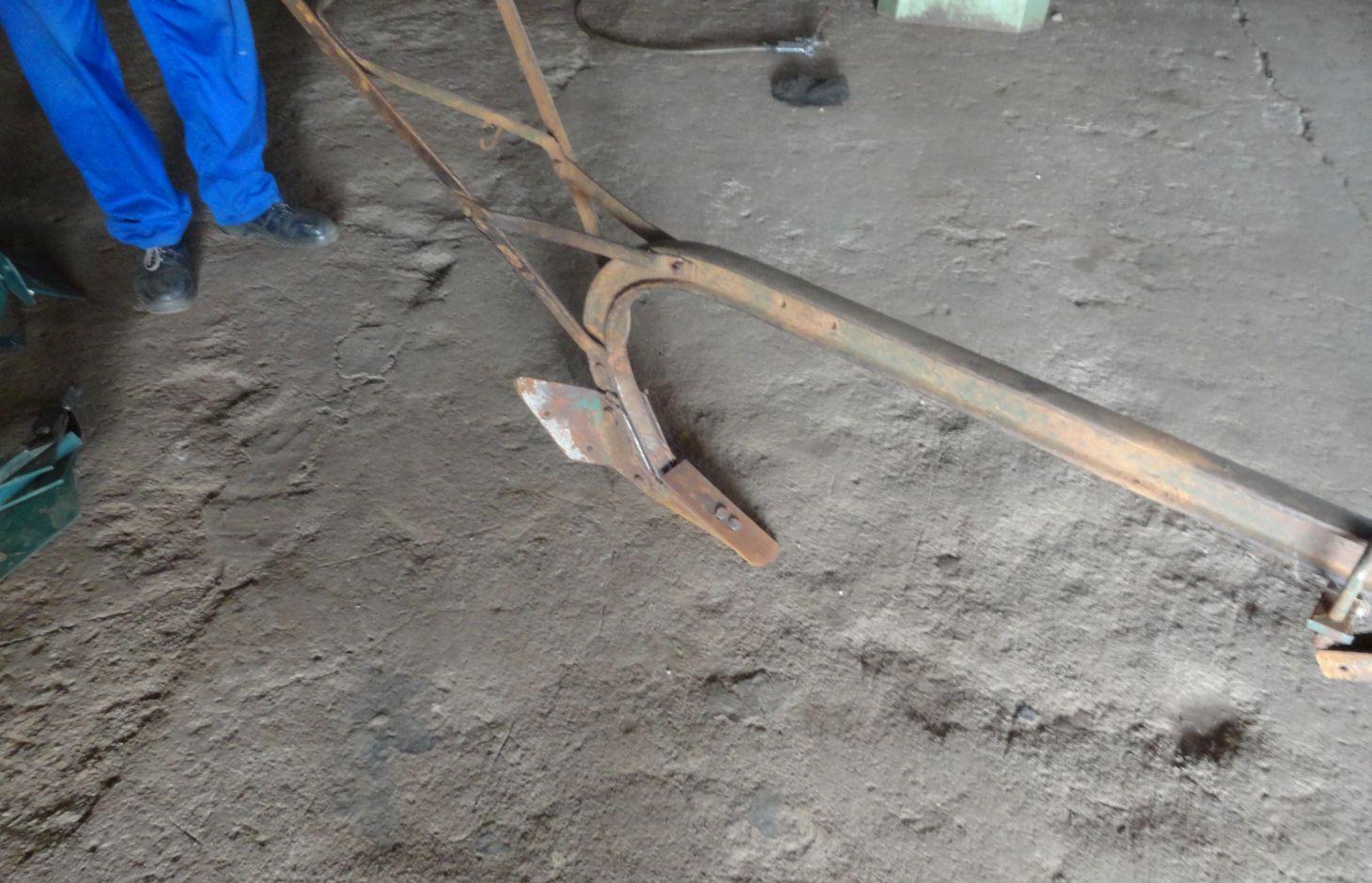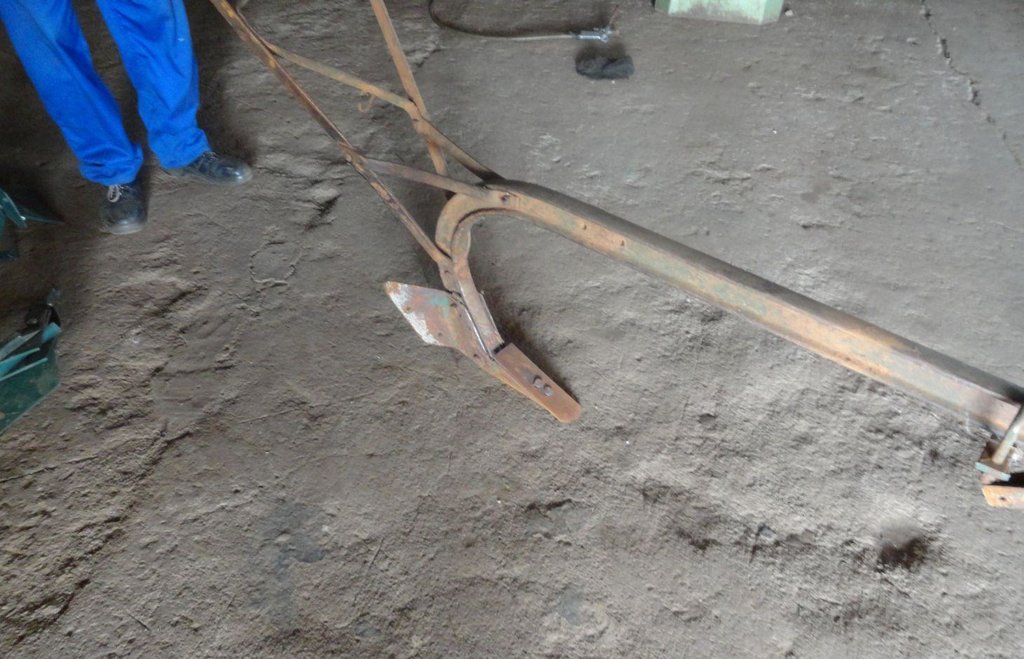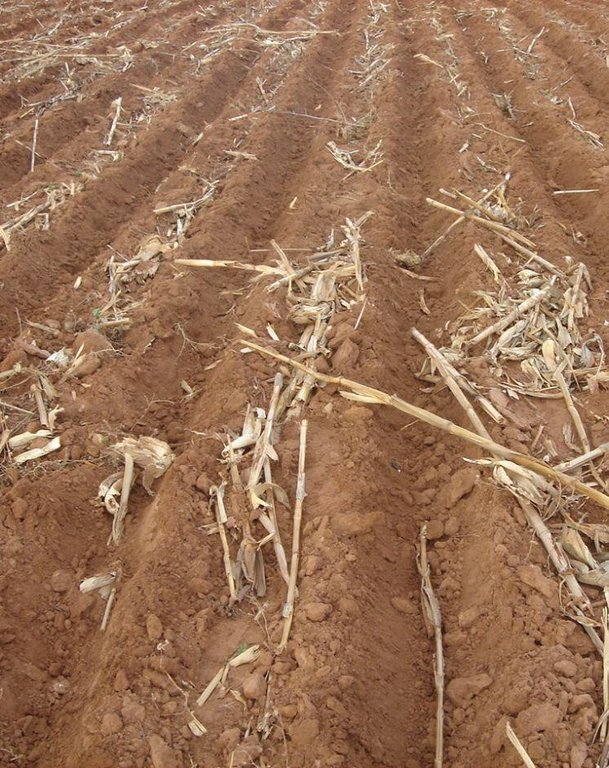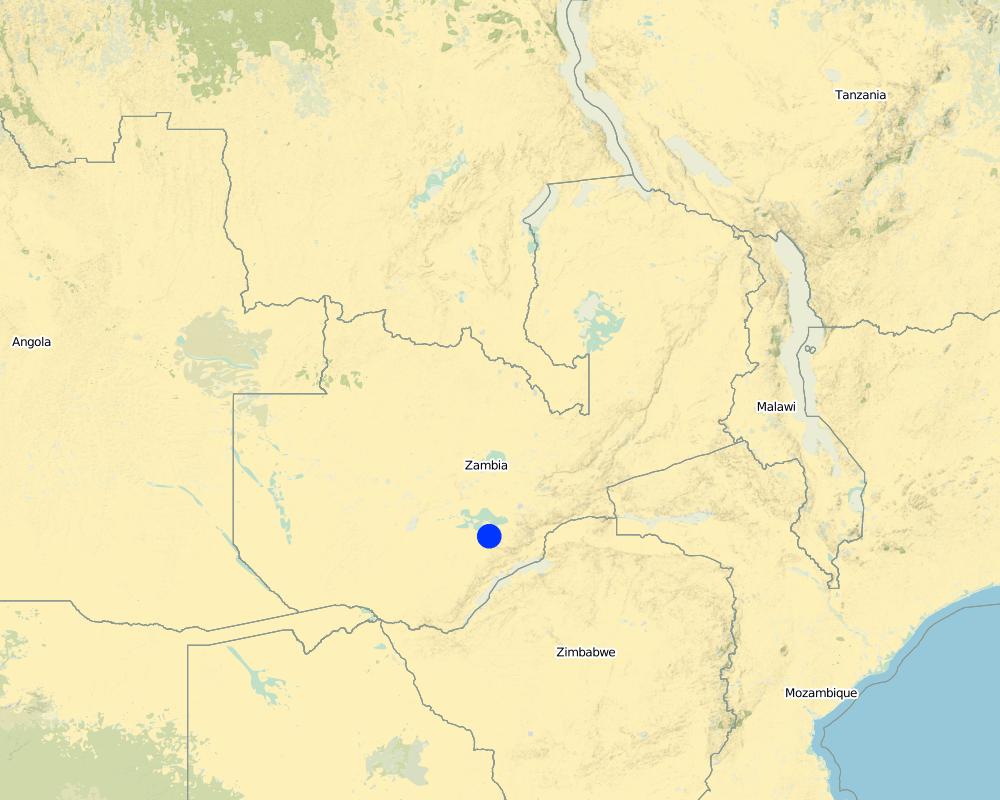Conservation Tillage with Magoye Ripper [Zâmbia]
- Criação:
- Atualização:
- Compilador/a: Silenga Wamunyima
- Editor: –
- Revisores: Fabian Ottiger, Alexandra Gavilano
Minimum tillage
technologies_1139 - Zâmbia
Veja as seções
Expandir tudo Recolher tudo1. Informação geral
1.2 Detalhes do contato das pessoas capacitadas e instituições envolvidas na avaliação e documentação da tecnologia
Especialista em GST:
Especialista em GST:
Katoweji Alfred
Golden Valley Agricultural Research Trust
Zâmbia
Especialista em GST:
Ndandula Sharon
Golden Valley Agricultural Research Trust
Zâmbia
Nome da(s) instituição(ões) que facilitou(ram) a documentação/ avaliação da Tecnologia (se relevante)
Golden Valley agricultural research trust (Golden Valley agricultural research trust) - Zâmbia1.3 Condições em relação ao uso da informação documentada através de WOCAT
O/a compilador/a e a(s) pessoa(s) capacitada(s) aceitam as condições relativas ao uso de dados documentados através da WOCAT:
Sim
1.5 Referência ao(s) questionário(s) sobre abordagens GST (documentado(s) usando WOCAT)
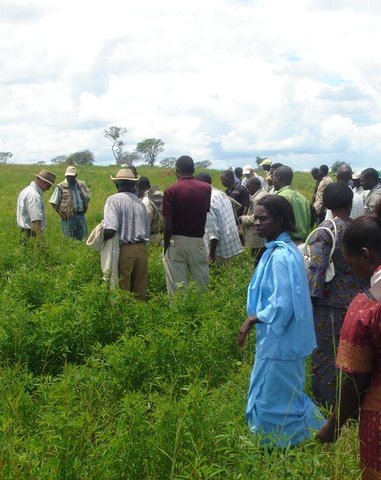
Participatory Research and Development [Zâmbia]
This is a collaborative process between researchers and farmers for developing and adapting new technologies that focus on incorporating the perspectives and inputs from the farmers into the development process.
- Compilador/a: Arthur Chomba
2. Descrição da tecnologia de GST
2.1 Descrição curta da tecnologia
Definição da tecnologia:
Conservation Tillage with the Magoye Ripper is an animal draft reduced tillage method that involves the use of the Magoye Ripper to loosen the soil by shattering with a tine instead of ploughing.
2.2 Descrição detalhada da tecnologia
Descrição:
The Magoye Ripper is an animal drawn implement used for conservation tillage. The Ripper consists of a frame that is attached to a common plough beam and on this frame is fixed a tine at an angle that penetrates and breaks up the soil when pulled. Only the region where the crop furrow will be is loosened by the tine and by so doing reducing the amount of tillage and disruption of soil structure while preserving the crop residue cover. The frame has some ‘wings’ attached to it that throw the soil out of the ripped furrow to leave it open for planting and collecting of water. Ripping is done in one pass up to a depth of 15cm depending on the strength of the oxen, soil type, hitch assembly settings and the sharpness of the tine.
Purpose of the Technology: Reducing tillage first of all reduces tillage costs and tillage time allowing more time for the farmer to plant early and/or a bigger area. Reducing tillage also reduces the loss of soil organic matter and the destructive effects to the soil structure ultimately improving soil fertility and soil water conservation. Ripping does not invert the soil, hence it does not bury crop residues which further enhance organic matter levels and protect the soil from excessive evaporation and erosion. The open furrow left by the ripper collects water from the adjacent untilled soil much in the same way basins (zai system) are used for water harvesting. This together with the increased rooting depth resulting from the breaking of compacted soil, enhanced infiltration and early planting improves water conservation and hence the resilience of crop to extended dry spells.
Establishment / maintenance activities and inputs: The establishment of ripping based conservation tillage mainly involves the purchase of the ripper frame and the
replaceable tines. Liming acidic soils (low pH soils) followed by a final ploughing will be required to correct the soil pH which otherwise will be difficult to correct once conservation tillage has been established. The main establishment activity involves adopting a new mindset and increasing the knowledge base to apply the technology correctly. Knowledge about alternative weed control practices and herbicide use is particularly cardinal as the farmer will have to adopt new weeding practices and routines in the absence of ploughing. Maintenance activities are more or less the same as conventional tillage except for replacing the tillage tines which wear every now and then. The same applies for the inputs except for the increase in use of herbicides.
Natural / human environment: Ripping is best performed in dry season when the soil is dry although this may not be possible with some of the smaller and/or weak oxen when the soil is too dry. It is therefore recommended for farmers in regions that experience long dry seasons to rip at the end of harvest before the soils get too dry and hard and when the oxen are in good condition before they lose weight and strength due to less feed and water, excessive heat as the dry season progresses.
The ripper is mostly suited to small-scale farmers just adopting Conservation Agriculture (CA) since the tool can be easily adapted to the existing plough beam which most of the farmers already have. The small capital outlay for establishing the system makes it suited to resource poor and risk-averse farmers.
2.3 Fotos da tecnologia
2.5 País/região/locais onde a tecnologia foi aplicada e que estão cobertos nesta avaliação
País:
Zâmbia
Região/Estado/Província:
Zambia/Southern Province
Especificação adicional de localização:
Mazabuka/Magoye
Especifique a difusão da tecnologia:
- Uniformemente difundida numa área
Se a área precisa não for conhecida, indicar a área aproximada coberta:
- 0,1-1 km2
Map
×2.6 Data da implementação
Caso o ano exato seja desconhecido, indique a data aproximada:
- 10-50 anos atrás
2.7 Introdução da tecnologia
Especifique como a tecnologia foi introduzida:
- durante experiências/ pesquisa
Comentários (tipos de projeto, etc.):
The Magoye Ripper was introduced in 1995 after a period of adaptive research by government research branch under a project supported by the Netherlands government.
3. Classificação da tecnologia de GST
3.1 Principal/principais finalidade(s) da tecnologia
- Reduz, previne, recupera a degradação do solo
- Protege uma bacia/zonas a jusante – em combinação com outra tecnologia
3.2 Tipo(s) atualizado(s) de uso da terra onde a tecnologia foi aplicada

Terra de cultivo
- Cultura anual
Número de estações de cultivo por ano:
- 1
Especifique:
Longest growing period in days: 135 Longest growing period from month to month: Mid November to end of March
Comentários:
Major land use problems (compiler’s opinion): Loss of soil structure and loss of soil fertility
Major land use problems (land users’ perception): Droughts and dry dpells
Livestock is grazing on crop residues
3.4 Abastecimento de água
Abastecimento de água para a terra na qual a tecnologia é aplicada:
- Precipitação natural
3.5 Grupo de GST ao qual pertence a tecnologia
- Perturbação mínima ao solo
3.6 Medidas de GST contendo a tecnologia

Medidas agronômicas
- A2: Matéria orgânica/fertilidade do solo
- A3: Tratamento da superfície do solo
- A7: Outros
A3: Diferenciar os sistemas de lavoura:
A 3.2: Reduced tillage (> 30% soil cover)
Comentários:
Main measures: agronomic measures
Specification of other agronomic measures: Reduced Tillage, Crop Residues
Type of agronomic measures: early planting, mulching, manure / compost / residues, mineral (inorganic) fertilizers, soil conditioners (lime, gypsum), rotations / fallows, breaking compacted topsoil, minimum tillage, non-inversion tillage, furrows (drainage, irrigation), breaking compacted subsoil
3.7 Principais tipos de degradação da terra abordados pela tecnologia

Erosão do solo pela água
- Wt: Perda do solo superficial/erosão de superfície

Deteriorização química do solo
- Cn: declínio de fertilidade e teor reduzido de matéria orgânica (não causado pela erosão)

Deteriorização física do solo
- Pc: Compactação

Degradação biológica
- Bl: perda da vida do solo
Comentários:
Main type of degradation addressed: Cn: fertility decline and reduced organic matter content, Pc: compaction, Bl: loss of soil life
Secondary types of degradation addressed: Wt: loss of topsoil / surface erosion
Main causes of degradation: soil management (Over-ploughing), crop management (annual, perennial, tree/shrub) (Monocropping), overgrazing (Crop residues overgrazed leaving land exposed), poverty / wealth (under application of fertilizer leading to nutrient mining, charcoal burning)
Secondary causes of degradation: deforestation / removal of natural vegetation (incl. forest fires) (Charcoal burning), Heavy / extreme rainfall (intensity/amounts) (high intensity storms leading to erosion), droughts (resulting in inadequate soil cover), land tenure (communal land over-exploited), governance / institutional (lack of credit facilities)
3.8 Redução, prevenção ou recuperação da degradação do solo
Especifique o objetivo da tecnologia em relação a degradação da terra:
- Reduzir a degradação do solo
Comentários:
Secondary goals: prevention of land degradation, rehabilitation / reclamation of denuded land
4. Especificações técnicas, implementação de atividades, entradas e custos
4.1 Desenho técnico da tecnologia
Autor:
Silenga Wamunyima, Box 670577, Mazabuka, Zambia
4.2 Informação geral em relação ao cálculo de entradas e custos
Outro/moeda nacional (especifique):
Kwacha
Se for relevante, indique a taxa de câmbio do USD para moeda local (por exemplo, 1 USD = 79,9 Real): 1 USD =:
5,0
Indique a média salarial da mão-de-obra contratada por dia:
2.40
4.3 Atividades de implantação
| Atividade | Periodicidade (estação do ano) | |
|---|---|---|
| 1. | Purchase magoye ripper | |
| 2. | Purchase knapsack sprayer |
Comentários:
Lifespan of the magoye ripper: 7 years
Lifespan of the Knapsack sprayer: 5 years
4.4 Custos e entradas necessárias para a implantação
| Especifique a entrada | Unidade | Quantidade | Custos por unidade | Custos totais por entrada | % dos custos arcados pelos usuários da terra | |
|---|---|---|---|---|---|---|
| Equipamento | Magoye ripper | Tool | 1,0 | 50,0 | 50,0 | 100,0 |
| Equipamento | Knapsack sprayer | Tool | 1,0 | 80,0 | 80,0 | 100,0 |
| Custos totais para a implantação da tecnologia | 130,0 | |||||
| Custos totais para o estabelecimento da Tecnologia em USD | 26,0 | |||||
Comentários:
Duration of establishment phase: 5 month(s)
4.5 Atividades recorrentes/manutenção
| Atividade | Periodicidade/frequência | |
|---|---|---|
| 1. | slashing and spreading residues | May-June yearly after harvest |
| 2. | Ripping | May-June after harvest |
| 3. | Liming | Nov-Dec before planting |
| 4. | Planting and fertilizing | Nov-Dec at onset of rains |
| 5. | chemical weeding | 3 times |
| 6. | harvesting | April-May |
4.6 Custos e entradas necessárias pata a manutenção/atividades recorrentes (por ano)
| Especifique a entrada | Unidade | Quantidade | Custos por unidade | Custos totais por entrada | % dos custos arcados pelos usuários da terra | |
|---|---|---|---|---|---|---|
| Mão-de-obra | Slashing and spreading residues | ha | 1,0 | 20,0 | 20,0 | 100,0 |
| Mão-de-obra | Ripping | ha | 1,0 | 50,0 | 50,0 | 100,0 |
| Mão-de-obra | Liming | ha | 1,0 | 42,0 | 42,0 | 100,0 |
| Mão-de-obra | Planting and fertilizing | ha | 1,0 | 40,0 | 40,0 | 100,0 |
| Material vegetal | Seeds | kg | 20,0 | 2,5 | 50,0 | 100,0 |
| Fertilizantes e biocidas | Fertilizer | kg | 400,0 | 0,8 | 320,0 | 100,0 |
| Outros | Herbicides | liters | 5,0 | 6,0 | 30,0 | 100,0 |
| Outros | Labour: Chemical weeding | ha | 1,0 | 24,0 | 24,0 | 100,0 |
| Outros | Labour: Harvesting | ha | 1,0 | 20,0 | 20,0 | 100,0 |
| Custos totais para a manutenção da tecnologia | 596,0 | |||||
| Custos totais de manutenção da Tecnologia em USD | 119,2 | |||||
Comentários:
Machinery/ tools: Magoye Ripper
Calculation are for a 1ha of maize under magoye ripper based conservation tillage and costs are for the Zambia situation in Magoye as of August 2012.
4.7 Fatores mais importantes que afetam os custos
Descreva os fatores mais determinantes que afetam os custos:
The weed control method employed is the main determinate factor depending on whether the farmer uses hand hoe or herbicides. Abandoning ploughing leads to higher weed densities leading to increased labour requirements/recurrent costs if hand weeding is used. However, with herbicides the weeding labour demand and costs cost are much lower by a factor of about 5. Another major cost is that of fertilizer which makes up about half the cost hence the total cost will vary significantly depending on fertilizer cost.
5. Ambiente natural e humano
5.1 Clima
Precipitação pluviométrica anual
- <250 mm
- 251-500 mm
- 501-750 mm
- 751-1.000 mm
- 1.001-1.500 mm
- 1.501-2.000 mm
- 2.001-3.000 mm
- 3.001-4.000 mm
- > 4.000 mm
Especificações/comentários sobre a pluviosidade:
Average rainfall 700mm, summer rains from November to March.
Zona agroclimática
- Semiárido
Thermal climate class: subtropics. 3 distinct seasons – summer, winter and one rainy season
5.2 Topografia
Declividade média:
- Plano (0-2%)
- Suave ondulado (3-5%)
- Ondulado (6-10%)
- Moderadamente ondulado (11-15%)
- Forte ondulado (16-30%)
- Montanhoso (31-60%)
- Escarpado (>60%)
Formas de relevo:
- Planalto/planície
- Cumes
- Encosta de serra
- Encosta de morro
- Sopés
- Fundos de vale
Zona de altitude:
- 0-100 m s.n.m.
- 101-500 m s.n.m.
- 501-1.000 m s.n.m.
- 1.001-1.500 m s.n.m.
- 1.501-2.000 m s.n.m.
- 2.001-2.500 m s.n.m.
- 2.501-3.000 m s.n.m.
- 3.001-4.000 m s.n.m.
- > 4.000 m s.n.m.
Comentários e outras especificações sobre a topografia:
Slopes on average: Also flat and moderate (classed 2) and rolling (classed 3)
5.3 Solos
Profundidade do solo em média:
- Muito raso (0-20 cm)
- Raso (21-50 cm)
- Moderadamente profundo (51-80 cm)
- Profundo (81-120 cm)
- Muito profundo (>120 cm)
Textura do solo (solo superficial):
- Médio (limoso, siltoso)
- Fino/pesado (argila)
Matéria orgânica do solo superficial:
- Médio (1-3%)
- Baixo (<1%)
Caso disponível anexe a descrição completa do solo ou especifique as informações disponíveis, p. ex. tipo de solo, PH/acidez do solo, nitrogênio, capacidade de troca catiônica, salinidade, etc.
Soil fertility: Low (classed 1) and medium (classed 2, low fertility caused mainly by poor soil management practices, otherwise soil are inherently fertile)
Topsoil organic matter: Low (classed 1) and medium (classed 2, due to excessive ploughing and nutrient mining)
Soil drainage/infiltration: Good (classed 1, soils naturally are well drained except were soil have bee compacted by poor management practices) and medium (classed 2)
Soil water storage capacity: Medium (classed 1, soils mostly loam to sandy loam with medium storage capacity) and low (ranked 2)
5.4 Disponibilidade e qualidade de água
Lençol freático:
> 50 m
Disponibilidade de água de superfície:
Médio
Qualidade da água (não tratada):
Água potável boa
Comentários e outras especificações sobre a qualidade e a quantidade da água:
Ground water table: <50m (ranked 1, hand wells are <20m but reliable boreholes are > 50m) and 5-50m (ranked 2)
Availability of surface water: Medium (mostly seasonal streams and dams)
Water quality (untreated): Good drinking water (ranked 1, from hand pumps (both communal and private)) and poor drinking water (treatment required, from hand dug wells, ranked 1 also)
5.5 Biodiversidade
Diversidade de espécies:
- Médio
Comentários e outras especificações sobre biodiversidade:
Human population densities are relatively low
5.6 Características dos usuários da terra que utilizam a tecnologia
Rendimento não agrícola:
- 10-50% de toda renda
Nível relativo de riqueza:
- Muito pobre
- Pobre
Indivíduos ou grupos:
- Indivíduo/unidade familiar
Gênero:
- Homens
Indique outras características relevantes dos usuários da terra:
Land users applying the Technology are mainly common / average land users
Difference in the involvement of women and men: The technology is applied mostly by men since most households are male headed and animal traction operation are reserved for men. Planting and weeding operations are the domain of women and children
Population density: 10-50 persons/km2
Annual population growth: 3% - 4%
8% of the land users are rich and own 15% of the land (own more than 10 cattle).
8% of the land users are average wealthy and own 15% of the land (own between 5 and 10 cattle).
16% of the land users are poor and own 20% of the land (own less than 5).
68% of the land users are poor and own 40% of the land (do not own cattle).
Off-farm income specification: sale of rainfed crops makes up about half of their income, the remainder coming from sale of livestock, petty trading, hiring out labour and remittances
Market orientation of production system: Mixed (subsistence/ commercial, sale of excess maize and cotton, dairy, ranked 1) and subsistence (self-supply, livestock, maize and legumes for home consumption, ranked 2),
Level of mechanization: Animal traction (ranked 1, families without cattle borrow or hire), mechanised (ranked 2) and manual labour (ranked 2, only for small backyard fields)
5.7 Área média de terrenos utilizados pelos usuários de terrenos que aplicam a Tecnologia
- < 0,5 ha
- 0,5-1 ha
- 1-2 ha
- 2-5 ha
- 5-15 ha
- 15-50 ha
- 50-100 ha
- 100-500 ha
- 500-1.000 ha
- 1.000-10.000 ha
- > 10.000 ha
É considerado pequena, média ou grande escala (referente ao contexto local)?
- Pequena escala
Comentários:
Average area of land owned or leased by land users applying the Technology: Also: 5-15 ha, 15-50 ha, 50-100 ha
5.8 Propriedade de terra, direitos de uso da terra e de uso da água
Propriedade da terra:
- Indivíduo, não intitulado
Direitos do uso da terra:
- Acesso livre (não organizado)
- Indivíduo
- Land is apportioned by traditional leaders
Direitos do uso da água:
- Acesso livre (não organizado)
- Land is apportioned by traditional leaders
5.9 Acesso a serviços e infraestrutura
Saúde:
- Pobre
- Moderado
- Bom
Educação:
- Pobre
- Moderado
- Bom
Assistência técnica:
- Pobre
- Moderado
- Bom
Emprego (p. ex. não agrícola):
- Pobre
- Moderado
- Bom
Mercados:
- Pobre
- Moderado
- Bom
Energia:
- Pobre
- Moderado
- Bom
Vias e transporte:
- Pobre
- Moderado
- Bom
Água potável e saneamento:
- Pobre
- Moderado
- Bom
Serviços financeiros:
- Pobre
- Moderado
- Bom
6. Impactos e declarações finais
6.1 Impactos no local mostrados pela tecnologia
Impactos socioeconômicos
Produção
Produção agrícola
Quantidade anterior à GST:
1.8ton/ha
Quantidade posterior à GST:
2ton/ha
Comentários/especificar:
mostly due to early planting
Produção de forragens
Comentários/especificar:
crop residues needed for soil cover
Risco de falha de produção
Comentários/especificar:
Better tolerance to dry spells
Área de produção
Quantidade posterior à GST:
20%
Renda e custos
Despesas com insumos agrícolas
Comentários/especificar:
purchase of herbicides
Rendimento agrícola
Quantidade posterior à GST:
15%
Comentários/especificar:
due to lower tillage cost, better yield
Carga de trabalho
Comentários/especificar:
only if herbicicdes are used for weeding
Impactos socioculturais
Segurança alimentar/auto-suficiência
Comentários/especificar:
due to improved yields and more time and labour to diversify
Oportunidades de lazer
Comentários/especificar:
Less time spent preparing land
Atenuação de conflitos
Comentários/especificar:
competition for crop residues with neighbours cattle
Improved livelihoods and human well-being
Comentários/especificar:
Technology not yet been applied on a large enough area to make significant impact at community level but increased farm incomes among farmers has led to better education and health among household members.
Impactos ecológicos
Ciclo hídrico/escoamento
Qualidade de água
Comentários/especificar:
due to improved good drainage
Colheita/recolhimento de água
Comentários/especificar:
open furows collect water
Escoamento superficial
Comentários/especificar:
due to better soil cover
Drenagem de excesso de água
Comentários/especificar:
due to improved soil structure
Lençol freático/aquífero
Comentários/especificar:
not applied extensively
Evaporação
Comentários/especificar:
due to better soil cover
Solo
Umidade do solo
Comentários/especificar:
due to resulting improved soil srtucture
Cobertura do solo
Comentários/especificar:
Due to non-inversion tillage
Perda de solo
Comentários/especificar:
Due to less soil disturbance and better soil cover
Ressecamento/ selagem do solo
Comentários/especificar:
Due to less soil disturbance
Compactação do solo
Comentários/especificar:
Due to less soil disturbance
Ciclo e recarga de nutrientes
Comentários/especificar:
Due to less soil disturbance
Salinidade
Comentários/especificar:
due to resulting good drainage
Matéria orgânica do solo/carbono abaixo do solo
Comentários/especificar:
Due to less soil disturbance
Biodiversidade: vegetação, animais
Biomassa/carbono acima do solo
Comentários/especificar:
Due to less soil disturbance
Diversidade animal
Comentários/especificar:
due to increased soil organic matter (SOM)
Outros impactos ecológicos
Waterlogging
Comentários/especificar:
Open furrow collect water in times of excess rainfal
Soil erosion locally
Comentários/especificar:
If furrow are made along the slope
6.2 Impactos externos mostrados pela tecnologia
Disponibilidade de água
Comentários/especificar:
only if applied on a large scale
Caudal confiável e estável em período seco
Comentários/especificar:
only if applied on a large scale
Cheias de jusante
Comentários/especificar:
only if applied on a large scale
Sedimentação a jusante
Comentários/especificar:
only if applied on a large scale
Poluição de água subterrânea/rio
Comentários/especificar:
only if applied on a large scale
Danos em áreas vizinhas
Comentários/especificar:
only if applied on a large scale
6.3 Exposição e sensibilidade da tecnologia às mudanças climáticas graduais e extremos/desastres relacionados ao clima (conforme o ponto de vista dos usuários da terra)
Mudança climática gradual
Mudança climática gradual
| Estação do ano | aumento ou diminuição | Como a tecnologia lida com isso? | |
|---|---|---|---|
| Temperatura anual | aumento | não conhecido |
Extremos (desastres) relacionados ao clima
Desastres meteorológicos
| Como a tecnologia lida com isso? | |
|---|---|
| Temporal local | não bem |
| Tempestade de vento local | não conhecido |
Desastres climatológicos
| Como a tecnologia lida com isso? | |
|---|---|
| Seca | bem |
Desastres hidrológicos
| Como a tecnologia lida com isso? | |
|---|---|
| Inundação geral (rio) | não bem |
Outras consequências relacionadas ao clima
Outras consequências relacionadas ao clima
| Como a tecnologia lida com isso? | |
|---|---|
| Período de crescimento reduzido | bem |
Comentários:
Magoye ripper based conservation tillage should be applied in well drained fields to avoid water-logging in the ripped furrows during seasons of excess rainfall or events of heavy downpours.
6.4 Análise do custo-benefício
Como os benefícios se comparam aos custos de implantação (do ponto de vista dos usuários da terra)?
Retornos a curto prazo:
positivo
Retornos a longo prazo:
muito positivo
Como os benefícios se comparam aos custos recorrentes/de manutenção(do ponto de vista dos usuários da terra)?
Retornos a curto prazo:
positivo
Retornos a longo prazo:
muito positivo
Comentários:
Timely planting enables larger areas to be planted and better yields. In the long term, improved soil fertility and soil structure results in sustained improved yields. However, if herbicides are not used, the costs and labour requirements of weeding can result in negative benefits.
6.5 Adoção da tecnologia
Comentários:
250 land user families have adopted the Technology with external material support
Comments on acceptance with external material support: The farmers bought the Magoye Rippers at half price and over half of them abandoned the technology after the first or second year of use.
Comments on spontaneous adoption: Information on spontaneous adoption is not documented although there have been reports of this in other districts.
There is a little trend towards spontaneous adoption of the Technology
Comments on adoption trend: Availability of replacement tines and the increased weed challenge have been a major hindrances to widespread adoption.
6.7 Pontos fortes/vantagens/oportunidades da tecnologia
| Pontos fortes/vantagens/oportunidades na visão do usuário da terra |
|---|
|
Enables early planting How can they be sustained / enhanced? planting with the first heavy rainfall in November |
| Pontos fortes/vantagens/oportunidades na visão do/a compilador/a ou de outra pessoa capacitada |
|---|
|
necessitates early planting How can they be sustained / enhanced? Plant in November or early December with the onset of rainfall |
|
fewer operations hence lower costs How can they be sustained / enhanced? continuous emphasis on early land preparation (May to July/August) |
|
conserves water and soil How can they be sustained / enhanced? encourage crop diversification and crop rotation legumes |
6.8 Pontos fracos, desvantagens/riscos da tecnologia e formas de superá-los
| Pontos fracos/desvantagens/riscos na visão do usuário da terra | Como eles podem ser superados? |
|---|---|
| weeding is difficult when herbicides are not used | train land users on how to use herbicides |
| ripping is hardly attained in heavy soils in October | rip between May and July |
| Pontos fracos/vantagens/riscos na visão do/a compilador/a ou de outra pessoa capacitada | Como eles podem ser superados? |
|---|---|
| weed pressure | encourage land users to use herbicides and continuous weeding |
7. Referências e links
7.1 Métodos/fontes de informação
7.2 Referências às publicações disponíveis
Título, autor, ano, ISBN:
Impact study on the acceptance of the Magoye Ripper, Piet Stevens, David Samazaka, Ab Wanders, Douglas Moono, 2002
Disponível de onde? Custos?
GART/free
Título, autor, ano, ISBN:
Social-economic analysis of conservation agriculture in southern Africa, FAO, 2011
Disponível de onde? Custos?
FAO/free online
Título, autor, ano, ISBN:
Conservation farming in Zambia, Steven Haggblade, Gelson Tembo, October 2003
Disponível de onde? Custos?
INDABA Project, Michigan State University/free online.
Título, autor, ano, ISBN:
Conservation farming in Zambia, Conservation farming unit (CFU), 2011
Disponível de onde? Custos?
cfu@zamnet.zm
Links e módulos
Expandir tudo Recolher tudoLinks

Participatory Research and Development [Zâmbia]
This is a collaborative process between researchers and farmers for developing and adapting new technologies that focus on incorporating the perspectives and inputs from the farmers into the development process.
- Compilador/a: Arthur Chomba
Módulos
Não há módulos


